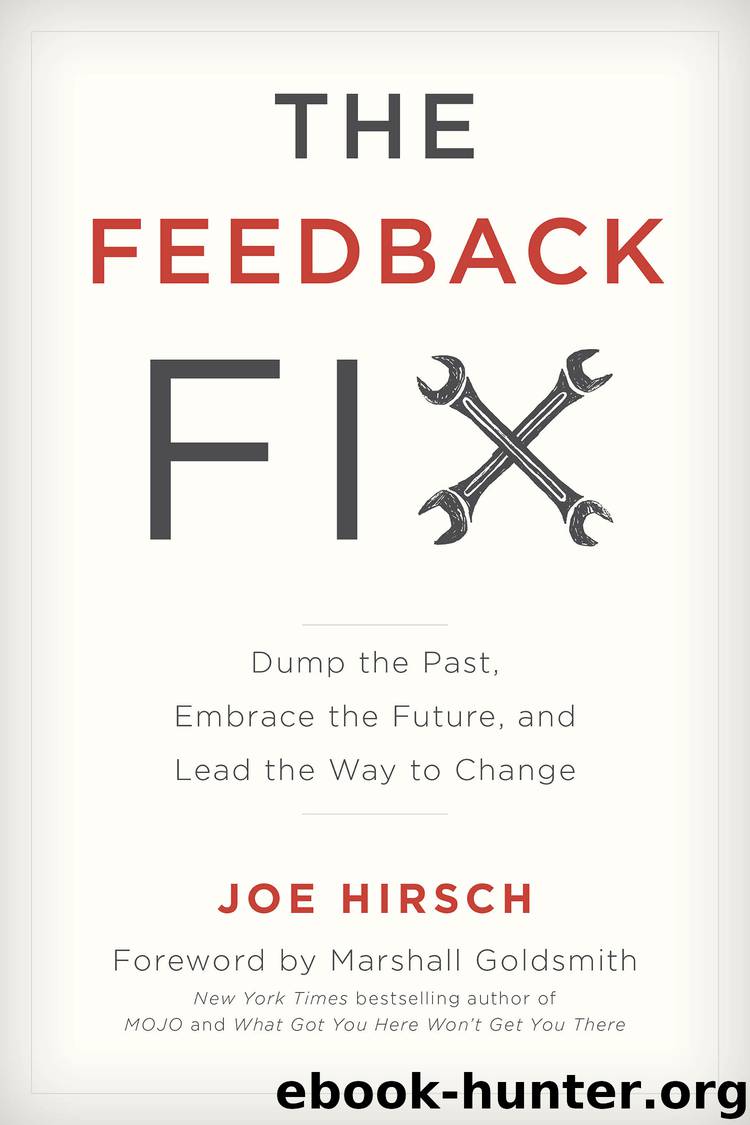The Feedback Fix by Joe Hirsch

Author:Joe Hirsch [Hirsch, Joe]
Language: eng
Format: epub
Publisher: Rowman & Littlefield Publishers
Published: 2017-04-05T04:00:00+00:00
Describe, don’t prescribe.
One thing at a time.
Treat all moments as equals.
Make it stick.
Trust yourself.
Describe, Don’t Prescribe
When it comes time to self-evaluate, we tend to exaggerate our sins and shortcomings. That’s the liability of closeness—we may be the ultimate insiders, but that proximity can also cause nearsightedness. We’re so close to the action that it’s almost impossible to have a clear-eyed view of actual events. What we think we’re seeing may be a crude distortion, for good or bad. Knowing that, it’s much more productive—and authentic—to describe the problem itself, rather than prescribe ways to fix it.
Just as you feel yourself begin to agonize over a challenging situation at work or home, pull back. Place yourself to the side for a moment and describe the scene: What do you feel, think, or see just before or during the encounter? Be precise and nonjudgmental. Don’t give in to unwarranted self-critique. By increasing our awareness and shedding our preconceptions, we separate the real from the imagined and sketch only what our senses tell us.
One effective way to do that is by labeling our emotions. That’s what researchers at UCLA discovered when they studied the reactions of people with spider phobias as they approached a dreaded arachnid. Participants were told to label their anxiety (verbalize the fear), think differently about the spider (what psychologists call reappraisal), or distract themselves entirely (look away at something else). The group that verbalized their fears showed the fewest signs of reactivity, suggesting that “naming the monster” can be a powerful way to sidestep the nightmare scenarios we all too often conjure up.
One Thing at a Time
The world today is more hyperactive than ever. We’re constantly in motion—toggling between apps, talking and texting at once, handling the home front at work and managing work worries at home. We know the drawbacks of multitasking—it’s harder to think, learn, and recall information—but recent findings show that it may even hamper our ability to rapidly switch between tasks. Researchers were amazed to discover that high multitaskers—those who reported using multiple forms of media simultaneously—took longer to switch tasks when prompted than those with lower multitasking tendencies.
The high multitaskers had a more difficult time filtering useful information from useless distractions. That caused them to treat every detail with equal importance and ignore cues that might have otherwise helped them rank and order the flow of information. There’s also evidence that suggests that even sitting in direct view of a multitasker can inhibit performance. If that leads to a drop-off in productivity, then multitasking can turn out to be more of a time-killer than a time-saver.
This is where feedforward can help. By demanding deep focus on the task at hand, it prevents the kind of attention loss that comes with task hopping. Devoting ourselves to one thing brings renewed energy, clarity, and purpose to every encounter. To turn multitasking into single-tasking, choose one item from your crammed agenda and take it for a deep dive. Or rank and rotate your list of
Download
This site does not store any files on its server. We only index and link to content provided by other sites. Please contact the content providers to delete copyright contents if any and email us, we'll remove relevant links or contents immediately.
The Art of Coaching Workbook by Elena Aguilar(50754)
Trainspotting by Irvine Welsh(21448)
Twilight of the Idols With the Antichrist and Ecce Homo by Friedrich Nietzsche(18452)
Fangirl by Rainbow Rowell(9027)
Periodization Training for Sports by Tudor Bompa(8097)
Change Your Questions, Change Your Life by Marilee Adams(7567)
This Is How You Lose Her by Junot Diaz(6702)
Asking the Right Questions: A Guide to Critical Thinking by M. Neil Browne & Stuart M. Keeley(5577)
Grit by Angela Duckworth(5449)
Red Sparrow by Jason Matthews(5322)
Paper Towns by Green John(5024)
Room 212 by Kate Stewart(4963)
Ken Follett - World without end by Ken Follett(4597)
Housekeeping by Marilynne Robinson(4253)
The Sports Rules Book by Human Kinetics(4216)
Papillon (English) by Henri Charrière(4146)
Double Down (Diary of a Wimpy Kid Book 11) by Jeff Kinney(4145)
The Motorcycle Diaries by Ernesto Che Guevara(3934)
Exercise Technique Manual for Resistance Training by National Strength & Conditioning Association(3906)
